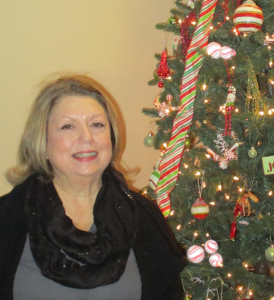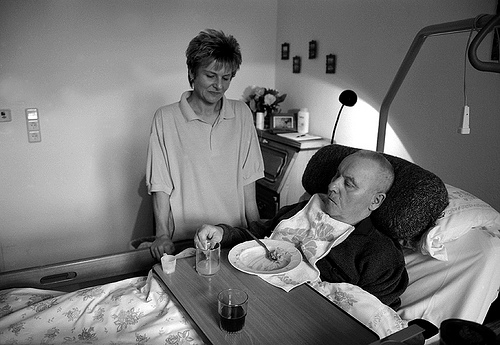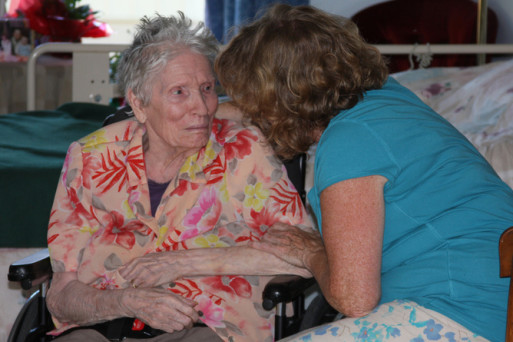Today, SevenPonds speaks with Linda Clark, a hospice volunteer at Journey Care in Illinois. As a volunteer, she assists patients with daily tasks and comforts family members who are coping with a relative’s terminal illness. Clark also contributes stories to the Windows Within Project, a hospice-sanctioned website that publishes stories from real hospice volunteers. The goal of the project is to highlight what makes hospice rewarding, and what patients have taught volunteers about the meaning of life and death.

Photo Source: Linda Clark
Marissa: Thanks for speaking with us, Linda. When did you start as a volunteer?
Linda: A little over three years ago, maybe a bit longer.
Marissa: Why did you become a volunteer?
Linda: I have volunteered my whole life in a variety of things. I’ve been an advocate for children in the family court system. When I was a teenager, I thought I wanted to be a nurse, then a doctor. Being a nurse was the easiest way to ease into being a doctor back in the dark ages because a lot of medical schools were not admitting females. When I was 15, I was accepted into a program in Connecticut that was a pre-nursing program. It was pretty intensive 40 hours of nursing training. In college, I majored in nursing, but then I changed my major. I’ve always had an interest in nursing.
I’ve been a Girl Scout leader; I’ve been a Boy Scout leader; I’ve been a Brownie leader; I’ve always done something. This time, I was looking for something more. My granddaughter was 20, so nobody needed me to do things on a daily basis. I really needed something I could get into, something important.
That’s when my daughter said, “You know, they’re building a hospice around here.” All this time went by, and I thought, “You know what? Something is calling me to this.” We all forget the reasons, but we probably all know that there’s something out there calling us. I contacted them to see what it was about, and it was just where I was supposed to be. I had no question.

Credit: Ulrich Joho
Marissa: That’s great. A lot of people never get that gratification with their work.
Linda: I think they don’t consciously get that. I have found there is something in hospice volunteer for everyone. You can stuff envelopes, play music or watch someone’s pet. Everybody is there for a reason, or they do something else.
I’m of an age where I get it; I get that we are only a blip on this radar for so long. My son is 51, and I tell him all the time that he is not listening to the universe. The universe is talking to you all the time. He tries to override it, to think too hard. If you just stop for a moment and breathe, it will talk to you, and it will put you exactly where you need to be.
I didn’t do volunteering because somebody died, and my heart was broken. I help train some of the new volunteers, and some of them do it for that reason. I don’t think you need a specific reason. I just think you hear a need.
Marissa: That’s a unique way to think of it. I have spoken to people who say that a specific moment made them want to become volunteers. Why do you think many people gravitate to this work naturally?
Linda: I can think of a story that shows what it’s like. I was [at work on] Monday, and a priest came in, and I didn’t know he was a priest. He came in with a woman, and I was at the desk when they walked by. When the woman was getting ready to leave, she said, “You know, my brother died in your care three years ago,” and she went on and on about how wonderful the nursing staff is.
Sometimes people do this work as part of community service, you know. But once you get there, regardless of why you’re there, you realize exactly what keeps people there is that the work is important. It was important to that woman that we were there.
Marissa: What do you do for patients and families as a volunteer?
Linda: I have a couple things. We do CNA-assist (Certified Nursing Assistant), which is what I thought initially I wanted to do. You assist with bathing, moving, feeding and so forth. What I usually sign up for is the care companion, which involves a little CNA-assist. But I interact with staff, I interact with patients’ families.
I think some of the important things we do are the little things that we never really notice we do. We hear that sometimes from family members down the road. It was a hand you took, a conversation you had while someone was getting a cup of coffee. I can read to somebody who is at the end of life and the family can’t be there. I’ll feed patients. I’ll visit with families at the worst time of their lives, and they need to talk to someone. Sometimes they need to talk with someone other than the family members in the room with them. They need that break, they need to walk away, and we’re there for them. I guess what I do is constantly interact.
Marissa: That makes sense, yeah.

Credit: simon_music
Linda: Sometimes the smallest gestures can have the biggest impact. One example: I knew that the family members of this patient were leaving to go to lunch. I had a very strong feeling that this patient wasn’t going to be around very much longer. I told the volunteer I was with, “I’m gonna be with this patient. I don’t want him to die alone.” I also didn’t want him to slip while I was going back and forth checking on rooms. I didn’t want the family to come back and find him gone without warning.
We have a man who is a volunteer who comes up and plays the acoustic guitar. He was there, so I walked over and opened the patient’s door wide so the last thing he heard was this beautiful guitar wafting through the door of this lovely room that he was in, and my hand on his shoulder. He did die before his family returned.
Marissa: It sounds like you always have a lot on your plate to consider when you’re a caregiver. Is there any advice you can give to people who are caring for someone who has a terminal illness, or who might be in the dying stages?
Linda: I think the family members are aching so much, but a lot of what they’re feeling is that the fighting of the disease is done. Now it’s the comfort and the care at the end of life. I see a lot of family dynamics. I see a lot of family members that just can’t let go. The patient wants to go, but some of the members just can’t let it go. I think sometimes you have to support them in realizing that what has happened to their loved one is the disease, and not their spirit. When they are frustrated, especially with diseases that cause dementia, or medications that have the same effects, and the patients are not themselves, it’s not personal, it’s the disease. It’s hard to remember because the family is still looking for that person.
Marissa: It’s definitely hard communicating with someone who is going through that. How do you navigate that?

Credit: CHEBA center for brain aging
Linda: One of the earliest things I learned is that people who are confused, they’re not coming into our world; we’re going into theirs. We’re being invited into the world that they are experiencing today. It’s brutal, but easier if you take that step back. Rather than saying “Remember? This is Wednesday. Remember? I’m your daughter.”
I had one guy, it was like the movie “Groundhog Day.” He was reliving a traumatic day at work, and he would ask me, “Do you hear the phone?” I would say, “Yes, I hear the phone.” Of course I didn’t hear the phone! But I did because he did. You have to take that moment and understand this is a very special world our patients live in. Whether it’s the world we’re living in or something they think themselves in the moment, we are invited into that world. If you just go with it, they share some wonderful stories. You hear about wonderful things that have happened to them, things about their kids, bits and pieces of their life, and you need to remember that this is a whole person. Whether they’re 15 years old or 103, they had full lives that we don’t know very much about.
Marissa: Thank you so much for taking the time to speak with us, Linda!
Linda: Thank you!
Read our interview with Mary York, founder of the Windows Within Project, here.

 How Should Caregivers Cope with Dementia? An Interview with Linda Clark
How Should Caregivers Cope with Dementia? An Interview with Linda Clark


 First the Wealth Gap, Now the U.S. Has a Growing Health Gap
First the Wealth Gap, Now the U.S. Has a Growing Health Gap

 Our Annual Seven Holiday Gifts for Someone Who Is Grieving, 2024 Edition
Our Annual Seven Holiday Gifts for Someone Who Is Grieving, 2024 Edition














